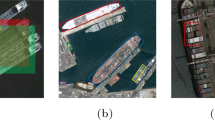Abstract
Multi-oriented objects widely appear in scene texts and optical remote sensing images, and thus rotation detection has received considerable attention. However, we observe that few arbitrary-oriented ship detection methods for synthetic aperture radar (SAR) images have been proposed before. The main reasons are the essential difference between SAR images and optical remote sensing images and the lack of labeled data for training rotation detectors. In addition, there also exist these problems of arbitrary orientation, large aspect ratio, and dense arrangement in SAR ship detection task. To address these above issues, an arbitrary-oriented ship detection method named FSFADet based on feature separation and feature alignment is proposed. Considering the lack of labeled SAR images, we establish a new SAR ship rotation detection dataset named SSRDD dataset, which is an important task when using arbitrary-oriented ship detection approaches for SAR data. A feature separation module (FS-Module) is introduced to enhance the ship object feature and weaken the background noise. Meanwhile, a refined network (R-Network) and a feature alignment module (FA-Module) are introduced to boost the SAR ship detection performance. Finally, the IoU-smooth L1 loss is introduced to the loss function to address the boundary problem. The simulation experiments show that the proposed method is superior to other arbitrary-oriented object detection methods.







Similar content being viewed by others
References
Lin H, Chen H, Jin K, Zeng L, Yang J (2020) Ship detection with superpixel-level fisher vector in high-resolution sar images. IEEE Geosci Rem Sens Lett 17(2):247–251
Chen C, He C, Hu C, Pei H, Jiao L (2019) MSARN: a deep neural network based on an adaptive recalibration mechanism for multiscale and arbitrary-oriented SAR ship detection. IEEE Access 7:159262–159283
Gao G (2011) A Parzen-Window-Kernel-Based CFAR algorithm for ship detection in SAR images. IEEE Geosci Rem Sens Lett 8(3):557–561
Zhang T, Jiang L, Xiang D, Ban Y, Pei L, Xiong H (2019) Ship detection from PolSAR imagery using the ambiguity removal polarimetric notch filter. ISPRS J Photogram Rem Sens 157:41–58
Wang S, Wang M, Yang S, Jiao L (2017) New hierarchical saliency filtering for fast ship detection in high-resolution SAR images. IEEE Trans Geosci Rem Sens 55(1):351–362
Wang C, Bi F, Zhang W, Chen L (2017) An intensity-space domain CFAR method for ship detection in HR SAR images. IEEE Geosci Rem Sens Lett 14(4):529–533
Xue R, Bai X, Zhou F (2021) Spatial-Temporal Ensemble Convolution for Sequence SAR Target Classification. IEEE Transactions on Geoscience and Remote Sensing 59(2):1250–1262. https://doi.org/10.1109/TGRS.2020.2997288
Wang L, Bai X, Gong C, Zhou F (2021) Hybrid inference network for few-shot SAR automatic target recognition. IEEE Trans Geosci Rem Sens. https://doi.org/10.1109/TGRS.2021.3051024
Wang L, Bai X, Xue R, Zhou F (2021) Few-shot SAR automatic target recognition based on Conv-BiLSTM prototypical network. Neurocomputing 443:235–246. https://doi.org/10.1016/j.neucom.2021.03.037
Li J, Qu C, Shao J (2017) Ship detection in SAR images based on an improved faster R-CNN. In Proc. SAR in Big Data Era: Models, Methods and Applications (BIGSARDATA). Beijing 2017:1–6
Chang YL, Anagaw A, Chang L, Wang Y, Hsiao CY, Lee WH (2019) Ship detection based on YOLOv2 for SAR imagery. Rem Sens 11(7):786
Ma J, Shao W, Ye H, Wang L, Wang H, Zheng Y, Xue X (2018) Arbitrary-oriented scene text detection via rotation proposals. IEEE Trans Multim 20(11):3111–3122
Jiang Y, Zhu X, Wang X, Yang S, Li W, Wang H, Fu P, Luo Z (2017) “R2CNN: rotational region CNN for orientation robust scene text detection,” arXiv:1706.09579, [online] Available: https://arxiv.org/abs/1706.09579
Azimi SM, Vig E, Bahmanyar R, Korner M, Reinartz P (2018) “Towards multi-class object detection in unconstrained remote sensing imagery,” In Proc. Asian Conference on Computer Vision, Perth, Australia, pp. 150-165
Yang X, Yang J, Yan J, Zhang Y, Zhang T, Guo Z, Xian S, Fu K (2019) “SCRDet: towards more robust detection for small, cluttered and rotated objects,” in Proc. Seoul, Korea (South), IEEE Int. Conf. Comput. Vis., pp 8231–8240
Xu Y, Fu M, Wang Q, Wang Y, Chen K, Xia G, Bai X (2020) Gliding vertex on the horizontal bounding box for multi-oriented object detection. IEEE Trans Pattern Anal Mach Intell. https://doi.org/10.1109/TPAMI.2020.2974745
Yang X, Liu Q, Yan J, Li A (2019) “R3Det: refined single-stage detector with feature refinement for rotating object,” a arXiv:1908.05612, [online] Available: https://arxiv.org/abs/1908.05612
Qian W, Yang X, Peng S, Guo Y, Yan C (2019) Learning modulated loss for rotated object detection, arXiv:1911.08299, [online] Available: https://arxiv.org/abs/1911.08299
Yang X, Yan J (2020) “Arbitrary-oriented object detection with circular smooth label,” arXiv:2003.05597, [online] Available: https://arxiv.org/abs/2003.05597
Yang X, Hou L, Zhou Y, Wang W, Yan J (2020) “Dense label encoding for boundary discontinuity free rotation detection,” arXiv:2011.09670, [online] Available: https://arxiv.org/abs/2011.09670
Wei S, Zeng X, Qu Q, Wang M, Su H, Shi J (2020) HRSID: a high-resolution SAR images dataset for ship detection and instance segmentation. IEEE Access 8:120234–120254
Zhang T, Zhang X, Ke X, Zhan X, Shi J, Wei S, Pan D, Li J, Su H, Zhou Y, Kumar D (2020) LS-SSDD-v1 0: a deep learning dataset dedicated to small ship detection from large-scale sentinel-1 SAR images. Rem Sens 12(18):2997
Lin T, Goyal P, Girshick R, He K, Dollar P (2017). Focal loss for dense object detection. Proc. IEEE Int. Conf. Comput. Vis, Venice, Italy, pp 2999–3007
Yang X, Yan J, Yang X, Tang J, Liao W, He T (2020) “SCRDet++: Detecting small, cluttered and rotated objects via instance-level feature denoising and rotation loss smoothing,” arXiv:2004.13316, [online] Available: https://arxiv.org/abs/2004.13316
Acknowledgements
The authors wish to thank Xue Yang et al. for their wonderful works.
Author information
Authors and Affiliations
Corresponding author
Ethics declarations
Conflict of interest
The authors declare that they have no conflict of interest.
Additional information
Publisher's Note
Springer Nature remains neutral with regard to jurisdictional claims in published maps and institutional affiliations.
Rights and permissions
About this article
Cite this article
Zhu, M., Hu, G., Li, S. et al. FSFADet: Arbitrary-Oriented Ship Detection for SAR Images Based on Feature Separation and Feature Alignment. Neural Process Lett 54, 1995–2005 (2022). https://doi.org/10.1007/s11063-022-10753-5
Accepted:
Published:
Issue Date:
DOI: https://doi.org/10.1007/s11063-022-10753-5




